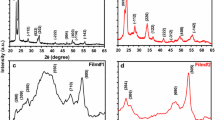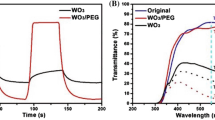Abstract
Tungsten oxide nanomaterials confined to one and two dimensions can be prepared with tungsten metal powder, tungsten chloride, peroxotungstic acid and acetylated peroxotungstic acid precursors by sol-gel, evaporation and electrodeposition techniques. Nanofibers and nanowires of tungsten oxide are synthesized by organic/inorganic blend of tungsten hexachloride, tungsten metal powder and polyvinylpyrrolidone with electrospinning technique. Standard and mesoporous tungsten oxide thin films are prepared from an ethanolic solution of tungsten hexachloride. Several polymers were employed as a template to generate the mesoporous structure. Additionally a detailed systematic study of the evaporated tungsten oxide thin films has been carried out at progressively increasing temperatures. Overall, the optical, electrochemical and structural properties of the deposited films were examined in both liquid and solid electrolytes. All solid electrochromic devices were fabricated using tungsten oxide active electrochromic layers. The fabrication and evaluation of a prototype solid-state electrochromic device are also described.
Similar content being viewed by others
References
X. Chi, Tungsten trioxide nanotubes with high sensitive and selective properties to acetone. Sensors and Actuators B: Chemical 194, 33–37 (2014)
S. Novak, Effect of ingested tungsten oxide (WOx) nanofibers on digestive gland tissue of porcellio scaber. Am. Chem. Soc. 47, 11284–11292 (2013)
J. Lee, Simple fabrication of flexible electrodes with high metal-oxide content electrospun reduced tungsten oxidecarbon nanofibers for lithium ion battery applications. Nanoscale 6, 10147–10155 (2014)
W. Li, Nanostructured WO3 thin film as a new anode material for lithium-ion batteries. Appl. Surf. Sci. 256, 2447–2452 (2010)
S. Cong, Y. Tian, Q. Li, Z. Zhao, F. Geng, Single-crystalline tungsten oxide quantum dots for fast pseudocapacitor and electrochromic applications. Adv. Mater. 26, 4260–4267 (2014)
Y. Qin, Nanowire (nanorod) arrays-constructed tungsten oxide hierarchical structure and its unique NO2-sensing performances. J. Alloys Compd. 615, 616–623 (2014)
T.A. Nguyen, S. Park, J.B. Kim, T.K. Kim, G.H. Seong, J. Choo, Y.S. Kim, Polycrystalline tungsten oxide nanofibers for gas-sensing applications. Sens. Actuators B: Chem. 160(1), 549–554 (2011)
C.V. Ramana, S. Utsunomiya, R.C. Ewing, C.M. Julien, U. Becker, Structural stability and phase transitions in WO3 thin films. J Phys. Chem. B 110, 10430–10435 (2006)
X. Chang, S. Shibin, Z. Li, X. Xu, Y. Qiu, Assembly of tungsten oxide nanobundles and their electrochromic properties. Elsevier, Appl. Surf. Sci. 257, 5726–5730 (2011)
J. Sungpanich, Fabrication of WO3 nanofibers by high voltage electrospinning. Mater. Lett. 65, 3000–3004 (2011)
k Bange, Colouration of tungsten oxide films: a model for optically active coatings. Elsevier, Solar Energy Mater. Solar Cells 58, 1–131 (1999)
E.K.H. Salje, S. Rehmann, F. Pobell, D. Morris, K.S. Knight, T. Herrmannsdorfer, M.T. Dove, Crystal structure and paramagnetic behaviour of e-WO3–x. J. Phys.: Condens. Matter 9, 6563–6577 (1997)
R. Chatten, A.V. Chadwick, A. Rougier, P.J.D. Lindan, The Oxygen Vacancy in Crystal Phases of WO3. J Phys. Chem. B 109, 3146–3156 (2005)
M.H. Kim, H.W. Choi, K.H. Kim, Properties of WO3–x electrochromic thin film prepared by reactive sputtering with various post annealing temperatures. IOP Jpn. Soc. Appl. Phys. 52, 11 (2013)
H. Miyazaki, Electrical and optical properties of amorphous and crystalline nondoped WO3–x films prepared by reactive RF sputtering. J. Appl. Phys. 47(9), 7295–7297 (2008)
E. Ozkan, S.H. Lee, P. Liu, C.E. Tracy, F.Z. Tepehan, J.R. Pitts, S.K. Deb, Electrochromic and optical properties of mesoporous tungsten oxide films. J. Solid State Ionics 149, 139–146 (2002)
R. Vittal, H. Gomathi, K.J. Kim, Beneficial role of surfactants in electrochemistry and in the modification of electrodes. Adv. Colloid Interface Sci. 119(1), 55–68 (2006)
W. Cheng, Y. Ju, P. Payamyar, D. Primc, J. Rao, C. Willa, M. Niederberger, Large-area alignment of tungsten oxide nanowires over flat and patterned substrates for room-temperature gas sensing. Angew. Chem. Int. Ed. 54(1), 340–344 (2015)
X. Chi, C. Liu, L. Liu, Y. Li, Z. Wang, X. Bo, C. Su, Tungsten trioxide nanotubes with high sensitive and selective properties to acetone. Sens. Actuators B: Chem. 194, 33–37 (2014)
P.V. Tong, N.D. Hoa, N.V. Duy, N.V. Hieu, Micro-wheels composed of self-assembled tungsten oxide nanorods for highly sensitive detection of low level toxic chlorine gas. RSC Advances 5(32), 25204–25207 (2015)
M. Ahmadi, S. Sahoo, R. Younesi, A.P. Gaur, R.S. Katiyar, M.J. Guinel, WO3 nano-ribbons: their phase transformation from tungstite (WO3·H2O) to tungsten oxide (WO3). J. Mater. Sci. 49(17), 5899–5909 (2014)
S. Salmaoui, F. Sediri, N. Gharbi, Characterization of h-WO3 nanorods synthesized by hydrothermal process. Polyhedron 29(7), 1771–1775 (2010)
G. Gu, B. Zheng, W.Q. Han, S. Roth, J. Liu, Tungsten oxide nanowires on tungsten substrates. Nano Lett. 2(8), 849–851 (2002)
T.D. Manning, I.P. Parkin, M.E. Pemble, D. Sheel, D. Vernardou, Intelligent window coatings: atmospheric pressure chemical vapor deposition of tungsten-doped vanadium dioxide. Chem. Mater. 16(4), 744–749 (2004)
H. Hassani, E. Marzbanrad, C. Zamani, B. Raissi, Effect of hydrothermal duration on synthesis of WO3 nanorods. J. Mater. Sci.: Mater. Electron. 22(9), 1264–1268 (2011)
R. Sahay, V. Thavasi, S. Ramakrishna, Design modifications in electrospinning setup for advanced applications. J. Nanomater. 17 (2011)
J. Díaz-Reyes, V. Dorantes-García, A. Pérez-Benítez, J.A. Balderas-López, Obtaining of films of tungsten trioxide (WO3) by resistive heating of a tungsten filament. Superficies Vacio 21(2), 12–17 (2008)
S.K. Deb, Opportunities and challenges in science and technology of WO3 for electrochromic and related applications. Sol. Energy Mater. Sol. Cells 92(2), 245–258 (2008)
Author information
Authors and Affiliations
Corresponding author
Editor information
Editors and Affiliations
Rights and permissions
Copyright information
© 2016 Springer International Publishing Switzerland
About this chapter
Cite this chapter
Zayim, E.O., Tabatabaei Mohseni, A. (2016). Structural and Optical Properties of Tungsten Oxide Based Thin Films and Nanofibers. In: Ünlü, H., Horing, N.J.M., Dabrowski, J. (eds) Low-Dimensional and Nanostructured Materials and Devices. NanoScience and Technology. Springer, Cham. https://doi.org/10.1007/978-3-319-25340-4_12
Download citation
DOI: https://doi.org/10.1007/978-3-319-25340-4_12
Published:
Publisher Name: Springer, Cham
Print ISBN: 978-3-319-25338-1
Online ISBN: 978-3-319-25340-4
eBook Packages: Chemistry and Materials ScienceChemistry and Material Science (R0)




